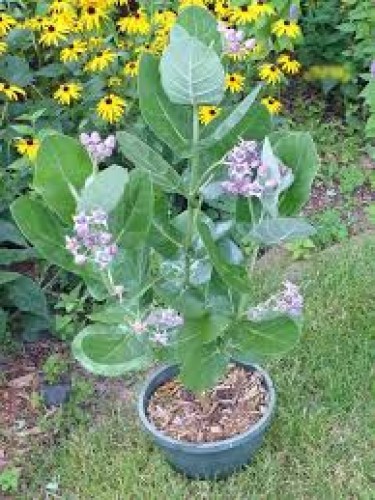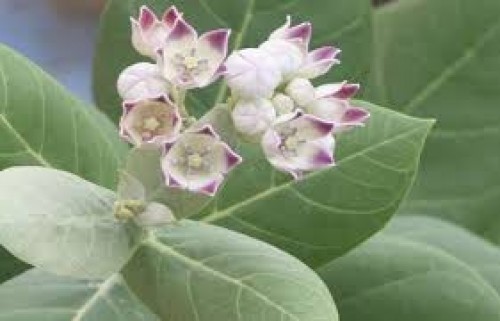off
-
Sold
-

-

out
Aak (Indian Milkweed) Plant: Nature, Care & Advantages
Aak (Botanical name: *Calotropis gigantea*), also known as Indian Milkweed, is a large, fast-growing shrub native to the Indian subcontinent and other parts of Asia. It is well-known for its striking flowers, which range from white to purple, and its resilience in harsh conditions. The plant produces a milky latex when cut, which gives it the name "milkweed." Aak is not only a medicinal plant but also plays a significant role in cultural and spiritual practices in India. It thrives in dry, rocky soils and is often found in wastelands and arid regions.
Nature of the Aak (Indian Milkweed) Plant
The Aak plant is a hardy shrub that can grow up to 2-3 meters in height. It has large, leathery, ovate leaves that are a silvery-green color, covered with fine hairs. The plant produces large, star-shaped flowers that vary in color from white to pale purple. These flowers bloom in clusters and are a striking feature of the plant. The plant is known for its thick, milky latex, which is secreted when the stems or leaves are damaged. Aak thrives in warm, tropical climates and can survive in dry, nutrient-poor soils, making it an excellent plant for arid and semi-arid regions. It is also drought-resistant and highly tolerant of hot conditions.
Care for the Aak (Indian Milkweed) Plant
- Climate: Aak plants are well-suited for tropical and subtropical climates. They require warm temperatures and are highly drought-resistant, making them ideal for dry regions. Full sunlight is necessary for the plant to thrive.
- Soil: The Aak plant grows well in well-drained, sandy, or loamy soils. It can tolerate poor soil conditions, but it performs best in slightly alkaline soil. It is not overly fussy about soil fertility but requires good drainage to prevent root rot.
- Watering: Aak is drought-tolerant and does not require frequent watering once established. It is crucial not to overwater the plant, as it can lead to root rot. Water the plant moderately during dry spells but allow the soil to dry out between waterings. Over-watering should be avoided.
- Sunlight: Aak plants require full sunlight to grow properly. They should be planted in areas where they can receive at least 6 hours of direct sunlight every day. Sunlight helps in the production of flowers and promotes strong growth.
- Pruning: While Aak does not require extensive pruning, it may benefit from the occasional removal of dead or damaged branches. Pruning can also help manage the plant’s size and shape, especially if it starts growing too large for the available space.
- Propagation: Aak plants can be propagated from seeds or stem cuttings. The seeds should be planted in well-drained soil, and the cuttings should be taken from healthy, mature stems. Both methods require some patience, as the plant takes time to establish itself.
Advantages of the Aak (Indian Milkweed) Plant
- Medicinal Uses: Aak has been used for centuries in traditional medicine for its various therapeutic properties. The plant is known for its ability to treat a wide range of ailments, including respiratory issues (like asthma and bronchitis), digestive disorders, and skin conditions. The milky latex contains compounds that are believed to have anti-inflammatory, analgesic, and antiseptic properties.
- Skin Health: The latex of the Aak plant is applied topically to treat wounds, cuts, and ulcers. It is also used to relieve pain and reduce swelling associated with arthritis. However, caution is required when using it on the skin, as it can be toxic if applied in excess.
- Respiratory Health: Aak is often used in Ayurvedic medicine to treat conditions such as asthma, cough, and bronchitis. Its medicinal properties help in relieving congestion, clearing the airways, and improving respiratory function. The leaves of the plant are sometimes used in the preparation of herbal remedies to ease breathing problems.
- Cultural Significance: The Aak plant holds religious and cultural importance, especially in Hinduism. The flowers of the Aak plant are considered sacred and are used in religious ceremonies, particularly in worshipping Lord Shiva. The plant is believed to have spiritual benefits, and its presence around temples is said to bring peace and blessings.
- Insect Repellent: The strong fragrance of Aak flowers and its latex is said to act as a natural insect repellent. Burning Aak leaves can help keep mosquitoes and other pests away, making it beneficial for both gardens and homes.
- Soil Erosion Control: The deep roots of the Aak plant help prevent soil erosion in dry and barren areas. This makes it useful in land reclamation and afforestation projects, as it can stabilize the soil and prevent further degradation of the land.
- Ecological Role: Aak is a hardy plant that can grow in tough conditions where other plants may not survive. Its resilience in arid and rocky soils makes it a valuable addition to barren landscapes, promoting biodiversity by providing a habitat for insects, especially pollinators like bees and butterflies.
Conclusion
The Aak (Indian Milkweed) plant is a versatile and resilient plant with many benefits, both medicinal and ecological. Its ability to thrive in dry, rocky soils and withstand drought makes it an ideal plant for arid regions. While it has cultural and spiritual significance, it also plays a vital role in traditional medicine, offering relief for various ailments. By following proper care guidelines, the Aak plant can be a valuable addition to your garden, landscape, or wellness routine.